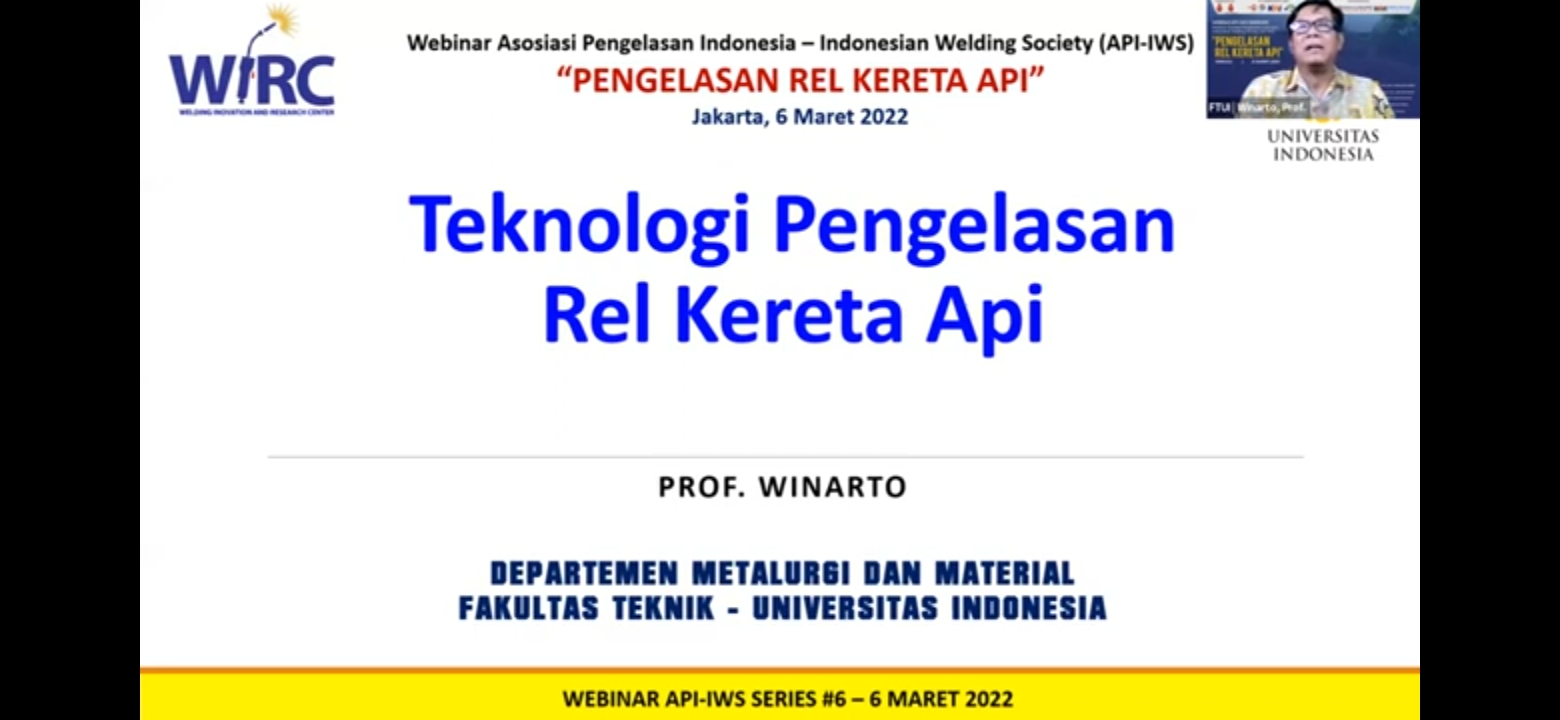The Indonesian Welding Association (API-IWS) held a webinar with the theme of Railroad Welding in collaboration with the Jabodetabek branch of API, PT KAI, Kampuh Group, Welding Study Center (WSC) on March 6, 2022. The webinar was also attended by Anjar Niryawan (President of API). -IWS), Ir. Moch Moenir (Governing Board API-IWS), Andi Rizaldi, ST, MM., (Expert Staff of the Minister of Industry for Business Climate and Investment).
The invited speakers for this webinar are Prof. Dr. Ir. Winarto, M. Sc, IWE (Professor and Head of Academic Quality Assurance Unit FTUI), and Ari Machmuddi Kanosri, IPM, IWE Manager Traction/Rolling Stock Reliability – PT Kereta Api Indonesia (KAI) (Persero). Both talk about Welding Technology and more specifically railroad welding.
The Dean of FTUI, Prof. Dr. Heri Hermansyah, ST., M.Eng., IPU revealed that this webinar is a regular activity held by API-IWS. “With this webinar, we can answer the widespread news in the mass media about Indonesian welding workers who are considered less capable of welding railroad tracks. Experts and human resources in Indonesia are actually capable and capable of welding railroad tracks.”
This webinar was attended by 215 participants from various circles such as practitioners, academics, industry, students and the general public which was held online. Participants came from various regions in Indonesia and abroad such as Taiwan. This shows the high interest and concern for welding in Indonesia.
As Professor of Welding Technology, Faculty of Engineering, University of Indonesia (FTUI), on this occasion Prof. Winarto delivered the material “Railway Welding Technology”. “There are quite a lot of problems with welding railroad tracks and indeed, welding railroads requires skilled and knowledgeable human resources. I was inspired to do research, especially in the railway sector. It should be remembered together that the train is a mass transportation that is needed by this beloved Indonesian nation,” said Prof. Winarto.
Metal joining or welding is the joining of materials by heating the base material with or without using pressure, and adding filler metal. Metal splicing is indispensable in the work of various things, including in the manufacture of trains and railroads. However, knowledge about welding methods is still poorly understood by the public. Thus, it is reflected in the quality of the weld. The quality of the weld is the key to the connection product that we refer to based on existing standards.
Some welding or welding, divided according to the source of energy. These energy sources include electrical energy, chemical reaction energy, mechanical energy, and light energy. Welding activities on railroads use sources of electrical energy, namely Fusion Arc Welding and Flash Butt Welding, as well as energy from chemical reactions, namely Thermit Welding and Gas Pressure Welding. Fusion Arc splicing is based on the principle that metals must be arc welded. Then the material will coalesce and harden. On the other hand, pressurized welding requires that the metal be arranged like a train, and can then be heated and pressed. The principle that people need to know is that the process of connecting trains is not easy.
“There are four purposes of welding railroad tracks. First, to increase the length of the rail track by connecting two or more rails. Then, welding can reduce the number of joints thereby increasing the strength of the joint and making the path economical. Third, repair the damaged rail by increasing its lifespan. Finally, the rail welding process is used by joining the ends of the rail heads by welding. This goal can be achieved with the welding principle that has been described previously,” said Prof. Winarto.
Continuing the previous explanation, Prof. Winarto compares the joining of Flash Butt with Thermit Welding. Flash Butt splicing uses an electric current of 35,000 A, while Thermit Welding uses a chemical reaction. In terms of quality, strength, cost, and time, welding with the Flash Butt system is superior to Thermit Welding. However, welding with the Thermit Welding system, the company does not have to strictly control it. This is different from Flash Butt which must be tightly controlled through a computer system.
“I have made a standard that was ratified through SNI regarding Flash Butt connections for rail roads. The standard covers the joining process using the Mobile Flash Butt Welding Machine method at Lintas, not using Fixed Pand. This standard applies to steel grades R269, R260mNM, and R30HT with rail profiles 54E1 and 60E1 referring to SNI 8936:2020,” said Prof. Winarto closed his presentation.
***
Public Communication Bureau
Faculty of Engineering, Universitas Indonesia

